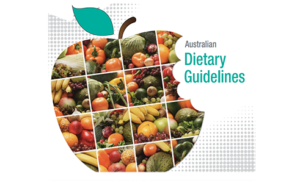The Dietary guidelines have been designed for us as a set of “eating rules” to help improve our everyday diets. The aim behind these guidelines is to help minimise and further prevent risk of diet-related illnesses such as:
 Diabetes
Diabetes- Heart Disease
- High Cholesterol
- High Blood Pressure
- Obesity
Below we discuss some of the Australian Dietary Guidelines.
- To achieve and maintain a healthy weight, be physically active we need to choose the right amounts of nutritious foods to meet your energy needs.
- During our younger years where we experienced rapid growth, we needed to consume sufficient quantities of nutritious food to support normal growth and development. As we get older, we still need to consume sufficient nutritious food to help maintain muscle growth and strength, and a healthy weight.
- Enjoy a wide variety of nutritious foods from these five groups every day.
- Varied vegetables, including legumes
- Varied Fruit
- Wholemeal grains and cereals that are high in fibre
- Low fat and lean meats: poultry; fish, eggs, chicken, red meat and tofu
- Low fat dairy products; milk, yoghurt & cheese and/or their alternatives
- And drink plenty of water
- Limit intake of foods containing saturated fat, added salt, added sugars and alcohol.
The guidelines suggest we limit the intake of foods and drinks that are high in saturated fats and sugars. Examples include soft drinks, fried foods, processed foods, biscuits, and cakes. We should also replace unsaturated and saturated fats with foods that are contain predominantly polyunsaturated and monounsaturated fats; the good fats.
Check out the Australian Dietary Guidelines for details.

